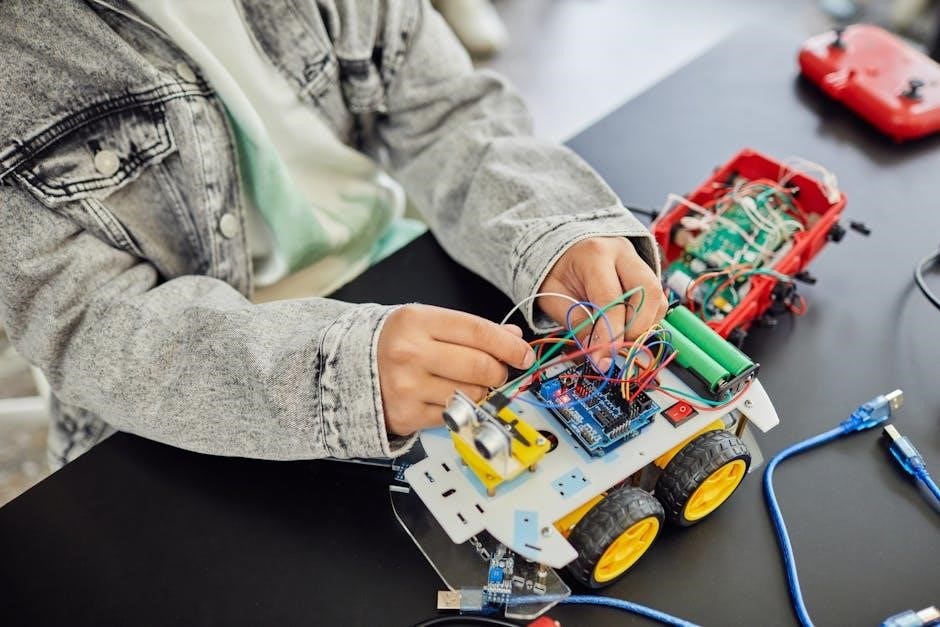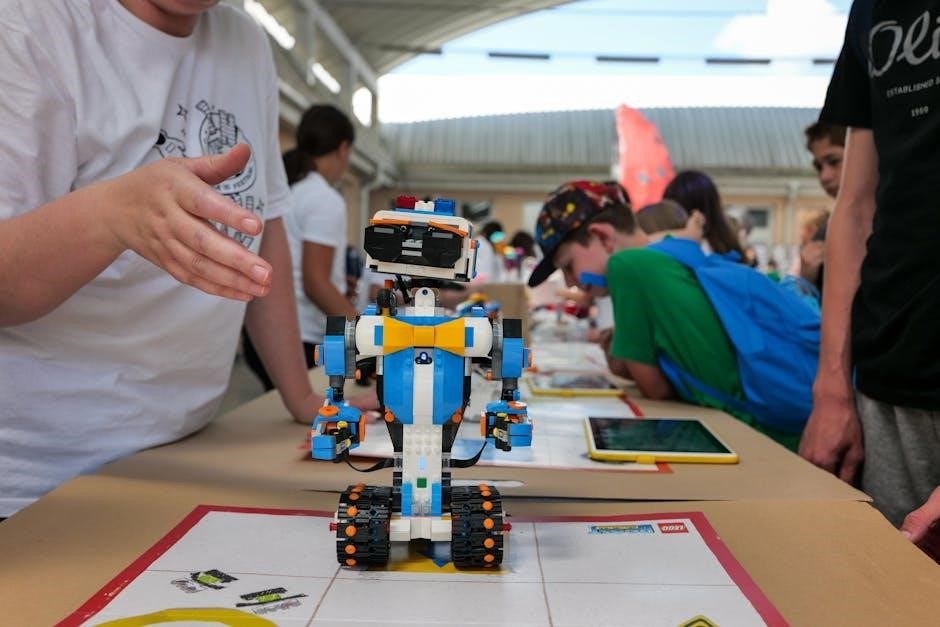The 6-in-1 Solar Robot Kit is an innovative, educational DIY project that combines science, creativity, and environmental learning. It allows users to build six different robotic models powered by solar energy, promoting STEM education and hands-on skill development. Perfect for kids and hobbyists, this kit fosters curiosity and innovation while teaching renewable energy concepts. With easy-to-follow instructions, it’s a fun and interactive way to explore robotics and sustainability.

Features of the 6-in-1 Solar Robot Kit

This kit offers six interchangeable robotic models, a solar panel, and a gearbox for smooth operation. It includes all necessary components, tools, and instructions for assembly. Perfect for STEM learning and creativity.
2.1 Six Different Models
The 6-in-1 Solar Robot Kit allows users to assemble six distinct robotic models, each with unique functionalities. These include a space station, space explorer, space dog, space rover, space shuttle, and astronaut. Each model is designed to showcase different mechanical movements and solar energy applications. The space station remains stationary but features rotating parts, while the space explorer moves forward with adjustable speed. The space dog and rover demonstrate walking and wheel-based locomotion, respectively. The space shuttle includes flapping wings, and the astronaut model highlights joint movements. These diverse designs provide a comprehensive understanding of robotics and solar power, catering to varying skill levels and interests. By building each model, users gain hands-on experience with gears, motors, and renewable energy systems, making it an engaging and educational project for both children and hobbyists.

2;2 Components and Tools Included
The 6-in-1 Solar Robot Kit comes with a comprehensive set of components and tools to ensure a smooth assembly process. Key components include a solar panel, gearbox, motors, gears, frames, and connecting parts. The solar panel is essential for harnessing energy, while the gearbox and motors enable movement in the robots. Frames and connecting parts provide the structural base for each model. Tools such as diagonal cutters, scissors, and a pencil are required for assembly. Additional items like screwdrivers and wrenches may be needed for adjusting or tightening parts. The kit is designed to be self-contained, with all necessary hardware included. This ensures users can focus on building and learning without searching for external materials. The components are durable and reusable, allowing for multiple model builds and modifications. Clear instructions guide users through each step, making the kit accessible to both beginners and experienced builders.
2.3 Solar Panel and Gearbox
The 6-in-1 Solar Robot Kit features a high-efficiency solar panel and a versatile gearbox, which are central to its functionality. The solar panel converts sunlight into electrical energy, powering the robots without the need for batteries. It is designed to optimize energy absorption, ensuring consistent performance even in varying light conditions. The gearbox, on the other hand, is a critical mechanical component that enables the robots to move. It houses the motors and gears, allowing for precise control over speed and direction. Together, the solar panel and gearbox provide the energy and mechanical systems needed to bring the six different robotic models to life. The gearbox is pre-assembled, making it easier for users to focus on building and customizing their robots. This combination of renewable energy and mechanical simplicity makes the kit both educational and environmentally friendly, while also promoting hands-on learning and creativity. The solar panel and gearbox are durable and reusable, ensuring long-term functionality across multiple builds. Proper alignment and assembly of these components are essential for optimal performance, as outlined in the kit’s instructions. By harnessing solar power and mechanical engineering, the kit offers a unique blend of innovation and practicality.

Educational Benefits of the Kit
The 6-in-1 Solar Robot Kit fosters creativity and problem-solving skills, teaching users about solar energy, mechanics, and sustainability. It offers hands-on learning, making STEM concepts engaging and accessible for all ages.
3.1 STEM Education
The 6-in-1 Solar Robot Kit is a powerful tool for STEM education, blending science, technology, engineering, and mathematics into a hands-on learning experience. By assembling and customizing different robotic models, users gain practical insights into mechanical engineering, renewable energy, and automation. The kit encourages curiosity and critical thinking, allowing learners to explore how solar power is harnessed and converted into motion. Through trial and error, users develop problem-solving skills and understand fundamental principles of robotics and energy efficiency. This interactive approach makes complex STEM concepts accessible and engaging, preparing learners for future challenges in technology and innovation.
3.2 Environmental Awareness
The 6-in-1 Solar Robot Kit fosters environmental awareness by introducing users to the concept of renewable energy and sustainability. By utilizing a solar panel to power the robots, the kit demonstrates how sunlight can be converted into mechanical energy, promoting eco-friendly values. This hands-on experience encourages learners to explore the potential of solar power and its role in reducing reliance on non-renewable energy sources. Building and operating solar-powered models helps users understand the importance of energy efficiency and conservation. The kit also highlights the practical applications of green technology, inspiring users to think creatively about environmental solutions; Through this interactive learning process, the 6-in-1 Solar Robot Kit contributes to a deeper appreciation for sustainable practices and the importance of protecting our planet for future generations.
3.3 Skill Development
The 6-in-1 Solar Robot Kit is designed to enhance a variety of skills, making it an excellent tool for learners of all ages. By assembling and customizing different robotic models, users develop hands-on engineering and problem-solving abilities. The process of building solar-powered robots teaches mechanical and electrical principles, fostering a deeper understanding of how components interact. Additionally, the kit encourages creativity and critical thinking, as users experiment with different designs and troubleshoot issues. The step-by-step instructions help improve patience and attention to detail, while the freedom to modify models inspires innovation. For younger learners, this kit lays a strong foundation in STEM fields, while for more experienced users, it offers opportunities to explore advanced concepts like coding and automation. Overall, the 6-in-1 Solar Robot Kit is a versatile learning tool that builds both technical and soft skills, preparing users for future challenges in science, technology, and engineering.

Assembly and Construction Guide
The 6-in-1 Solar Robot Kit includes a detailed manual with step-by-step instructions for assembling each model. Users can follow the guide to build robots using the provided tools and components, ensuring a smooth and educational hands-on experience.
4.1 Understanding the Manual
The manual for the 6-in-1 Solar Robot Kit is designed to be user-friendly, providing clear, step-by-step instructions for assembling each of the six models. It begins with an overview of the components and tools needed, ensuring users are prepared before starting. Each model has its own section, detailing specific assembly steps and highlighting key components like the solar panel and gearbox. Visual diagrams accompany written instructions, making it easier to understand complex parts. Additionally, the manual includes troubleshooting tips and safety precautions to ensure a smooth building process. By following the guide, users can efficiently construct their chosen model, gaining hands-on experience with solar energy and robotics. The manual also encourages creativity, offering suggestions for modifications and upgrades to further customize each robot. This comprehensive guide is essential for both beginners and experienced builders, making the assembly process enjoyable and educational.
4.2 Tools You Will Need
To successfully assemble the 6-in-1 Solar Robot Kit, you’ll need a few essential tools to ensure a smooth and efficient building process. First, gather basic tools like diagonal cutters for cutting wires, scissors for trimming excess plastic, and a pencil for marking parts. A flathead screwdriver is necessary for assembling components and tightening screws. Additionally, a small wrench or pliers may be required for adjusting tight connections. It’s also helpful to have a clean workspace with a soft cloth to prevent scratching delicate parts. Organizing the components in labeled containers can save time and reduce frustration. While the kit is designed to be user-friendly, having these tools ready will make the assembly process more enjoyable and streamlined. Always refer to the manual for specific tool recommendations, as some models may require additional items for proper construction.
4.3 Step-by-Step Assembly Instructions
Building the 6-in-1 Solar Robot Kit involves a series of straightforward steps that guide you through constructing each model. Start by carefully sorting and organizing the components according to the manual. For each model, follow the detailed diagrams to align parts correctly, ensuring proper fitting and alignment. Begin with the solar panel and gearbox, as these are the core components for all models. Attach the motor and gears according to the instructions, making sure they are securely fastened. Next, assemble the chassis and add the wheels or legs, depending on the model you’re building. Use the provided screws and tools to tighten all connections firmly. Once the basic structure is complete, test the solar panel to ensure it powers the gearbox. Repeat the process for each model, referring to the manual for specific instructions; Patience and attention to detail are key to a successful assembly.
4.4 Tips for Building Different Models
When constructing the various models from the 6-in-1 Solar Robot Kit, it’s essential to approach each design with precision and care. Start by thoroughly understanding the manual and identifying the specific parts required for each model. Organize components beforehand to avoid confusion. For complex models, break the assembly into smaller, manageable steps. Ensure the solar panel is correctly aligned and securely attached, as it powers the entire mechanism. Pay close attention to gear alignment, as improper fitting can hinder movement. Use the provided tools to tighten screws firmly but avoid overtightening, which may damage the parts. Test each model under direct sunlight to ensure optimal performance. For models with moving parts, such as the space rover or astronaut, verify that joints are flexible and wheels rotate smoothly. Finally, experiment with modifications once you’re comfortable with the basics, such as adjusting gear ratios or adding custom features. Patience and practice will enhance your building skills.

Testing and Troubleshooting
After assembling, test the robot in direct sunlight to ensure proper movement. Check the solar panel’s efficiency and gearbox functionality. Common issues include misaligned gears or insufficient sunlight. Refer to the manual for solutions.
5.1 Testing the Gearbox
Testing the gearbox is crucial to ensure smooth operation of the robot. Begin by assembling the gearbox according to the manual. Connect it to the solar panel and place the robot in direct sunlight. Observe if the gears rotate evenly without jamming. If the gears do not move, check for proper alignment and ensure all parts are securely attached. Lubricate the gears lightly if necessary. Verify that each gear meshes correctly and there are no obstructions. If issues persist, consult the troubleshooting section or online guides for further assistance. Proper gearbox function is essential for the robot’s mobility and efficiency.
5.2 Testing the Solar Panel
Testing the solar panel ensures it efficiently powers your robot. Begin by placing the panel in direct sunlight, avoiding shadows. Clean the panel with a soft cloth to remove dirt or smudges. Use a multimeter to measure voltage output, ensuring it matches the specifications in the manual; If the voltage is low, check the panel’s alignment with the sun or try a different location. Connect the panel to the gearbox to confirm power transmission. If the robot fails to move, verify all connections are secure and the gearbox is functioning properly. Troubleshoot issues like blocked sunlight or faulty wiring. Ensure the panel is angled correctly for maximum energy absorption. Proper solar panel operation is vital for the robot’s performance and reliability. Always follow safety precautions when handling electrical components. If issues persist, refer to the troubleshooting guide or online resources for additional support.

5.3 Common Issues and Solutions
When assembling and operating the 6-in-1 Solar Robot Kit, users may encounter several common issues. One frequent problem is the robot not moving, which can be due to insufficient sunlight, a faulty solar panel, or incorrect gearbox connections. Ensure the solar panel is clean and placed in direct sunlight. Check wiring connections between the solar panel and gearbox. If the issue persists, test the solar panel’s voltage using a multimeter to confirm it is functioning properly.
Another common issue is gears jamming or not aligning correctly. This can occur due to improper assembly or dirt in the gearbox. Carefully disassemble and clean the gears with a soft brush. Reassemble following the manual’s step-by-step guide. If gears still malfunction, ensure they are properly aligned and lubricated. For persistent problems, consult the troubleshooting section in the manual or seek guidance from online tutorials. Always double-check the assembly steps to avoid such issues. Regular maintenance and careful handling can prevent many common problems, ensuring smooth operation of your solar-powered robot.

Advanced Customization and Learning
Explore advanced modifications and coding to enhance your solar robot’s functionality. Learn to integrate sensors, program movements, and customize designs for unique behaviors, fostering deeper creativity and technical skills in robotics and automation.
6.1 Modifying Your Robot Designs
Once you’ve mastered building the six base models, you can take your creativity to the next level by modifying your robot designs. Experiment with additional components or repurpose parts to create unique robotic creations. Users have reported successfully adding sensors, altering gear ratios, and even integrating small motors for enhanced functionality. For instance, you can modify the solar panel placement to improve energy efficiency or adjust the gearbox to achieve different movement speeds. These modifications not only personalize your robots but also deepen your understanding of mechanical and electrical principles. Additionally, exploring custom designs encourages problem-solving and innovation, making the kit a versatile tool for advanced learners. Don’t hesitate to think outside the box—after all, the kit’s flexibility is designed to inspire endless creativity and experimentation.
The 6-in-1 Solar Robot Kit offers a gateway to coding and automation for those eager to explore advanced robotics. While the kit is primarily mechanical, it provides a foundation for integrating programmable elements. Users can experiment with adding microcontrollers like Arduino or Raspberry Pi to create automated movements and functions. By incorporating sensors and coding, you can program your robots to perform specific tasks, such as following a path or responding to environmental changes. This step introduces computational thinking, enabling you to transform your solar-powered creations into smart, interactive devices. Coding adds a new dimension to the kit’s educational value, teaching programming concepts and enhancing problem-solving skills. For those with basic coding knowledge, this is an exciting way to merge renewable energy with cutting-edge technology, fostering innovation and creativity.

Additional Resources and Support
The kit includes a detailed manual, and online resources offer guides, tutorials, and troubleshooting tips; Support communities and DIY forums provide additional help for users to enhance their projects.
7.1 User Manual and Specifications
The user manual for the 6-in-1 Solar Robot Kit is a comprehensive guide designed to help users understand and assemble the kit effectively. It includes detailed diagrams, step-by-step instructions, and troubleshooting tips to ensure a smooth building experience. The manual is structured into clear sections, starting with an inventory of components, followed by assembly instructions for each of the six models. It also covers the operation of the solar panel and gearbox, providing insights into how the robot harnesses solar energy. Specifications for each model are outlined, including dimensions, weight, and required tools. The manual is written in an easy-to-understand format, making it accessible to both beginners and experienced builders. Additional resources, such as wiring diagrams and part labels, are included to help users identify and resolve common issues. By following the manual, users can maximize their learning experience and enjoy the full potential of their solar-powered creations.
7.2 Online Guides and Tutorials
Supplementing the user manual, numerous online guides and tutorials are available to enhance your experience with the 6-in-1 Solar Robot Kit. These resources provide step-by-step video instructions, detailed diagrams, and troubleshooting tips to help users overcome common challenges. Many tutorials focus on specific models, such as the space rover or astronaut model, offering insights into their unique assembly and operation. Additionally, online forums and community platforms share user-generated content, including DIY modifications and creative builds. Video tutorials are particularly helpful for visual learners, showcasing how to properly connect the solar panel to the gearbox and ensure optimal energy transfer. These guides also cover advanced topics, such as optimizing performance in different light conditions and extending the kit’s capabilities. By leveraging these online resources, users can deepen their understanding of solar robotics and gain confidence in their building skills. This wealth of information ensures that learners of all levels can maximize their enjoyment and educational benefits from the kit.
7.3 DIY Modifications and Upgrades
Once you’ve mastered the basic models, the 6-in-1 Solar Robot Kit invites creativity through DIY modifications and upgrades. Users can experiment with additional components, such as extra gears, motors, or sensors, to enhance functionality. For instance, adding a small LED light or a buzzer can create interactive features. Some enthusiasts have even incorporated recycled materials, like plastic bottles or cardboard, to craft custom exteriors. Online communities share ideas for advanced builds, such as modifying the gearbox for faster movement or adjusting the solar panel angle for better energy absorption. These upgrades not only personalize the robots but also deepen the learning experience. With a little imagination, the kit becomes a platform for endless innovation, allowing users to push the boundaries of what’s possible with solar-powered robotics.
The 6-in-1 Solar Robot Kit is an exceptional educational tool that offers a blend of learning, creativity, and fun. By enabling users to build six distinct solar-powered robots, it fosters STEM knowledge, environmental awareness, and problem-solving skills. The kit’s modular design and comprehensive instructions make it accessible to learners of all ages and skill levels. Beyond its educational value, it encourages creativity and innovation, allowing users to experiment with modifications and upgrades. The integration of renewable energy highlights the importance of sustainability, making it a forward-thinking project. Whether for classroom use or personal enrichment, this kit provides a hands-on experience that sparks curiosity and passion for robotics and green energy. With its versatility and educational depth, the 6-in-1 Solar Robot Kit is an outstanding choice for anyone looking to explore science and technology in an engaging way.
